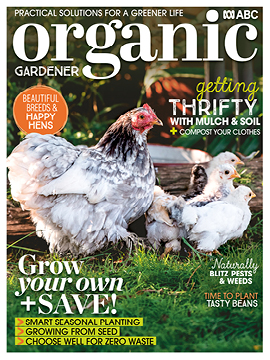Collecting native seeds
2022-08-01T06:44:32+10:00
Libby Woodward writes about how to grow plants from native seeds collected in your own garden.
The best place to start the native seed collection process is by buying and growing native plants from indigenous nurseries or propagating your own from purchased seed, or collect small amounts on private land. Once you have some plants it’s easy to collect your own seed. Some seeds can be direct sown with good success, but others will do better if sown into pots.
Establishing small native plants and native grasses by directly spreading seed on your garden can be difficult and we have had the best results in our garden from growing plants in tubes or plugs, then planting small areas and watering for their first summer. If you don’t want to do this, you can give the seed to your local indigenous nursery and ask them to grow the plants for you.
We have successfully direct seeded some small areas with grass seed but large quantities of seed, good ground preparation, weed control and good luck with rain or watering are all necessary.
Introduced lawn species have been grown for many years, with breeding ensuring they are easy to grow. This has not happened for native grasses and wildflowers. You need to collect enough seed from your own plants so that you are happy for a significant number to be wasted, as most seed in the natural environment does not grow into new plants. We managed to establish a small area of weeping grass (Microlaena stipoides) with direct sowing and will now collect seed from this and grow a larger area next year.
Collecting seeds for native grasses
Types you can collect: Weeping grass (Microlaena stipoides), purplish wallaby grass (Rytidosperma tenuius) and kangaroo grass (Themeda triandra).
Native grasses are easy to collect seed from, as long as you make sure the seed is ripe. The wallaby grass fluffs up when ripe and others easily come off when the seed stalk is run between your fingers. Kangaroo grass (pictured below) ripens from the top, so once this starts to drop you can pick the whole stalk at ground level and store upside down in a tall bucket. As the stalks dry out more of the seed ripens and drops into the bucket.
Germination: All the grasses grow well within a few weeks of planting, and don’t need treatment. But weeping and wallaby grass germination increases with light, so surface sow or only cover lightly with soil. Kangaroo and spear grasses corkscrew into the soil once they are watered. You can gently do this for them.

NOTE: Native seed should never be taken from the wild without a permit, as it’s illegal and can cause species to disappear from the environment over time. This is particularly true for small ground flora species. For these small plants to continue to survive in our reserves, public parks and roadsides they need to drop very large quantities of seed. This creates a seedbank in the soil that will germinate and grow in good years, replacing the short-lived parent plants.
Libby’s full article about collecting native seeds was in our Early Spring 2022 issue (OG 135). There’s a selection of back issues available here — you can also subscribe and get the most recent issues delivered to your door!







